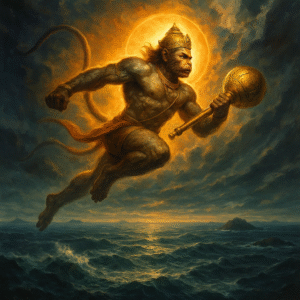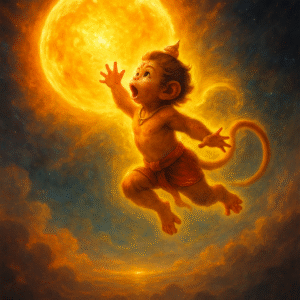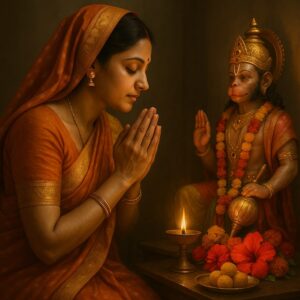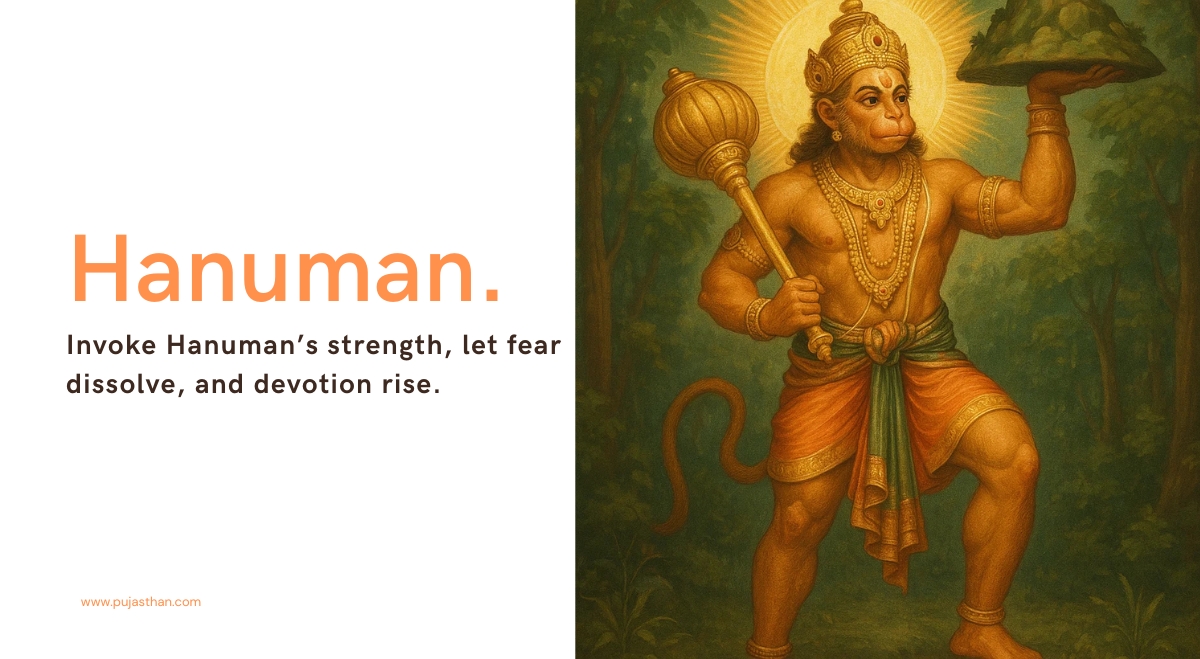Can you imagine a deity so powerful that he once carried an entire mountain? A being so humble that despite his strength, he bowed to love and service? That is Hanuman —the mighty Bajrangbali, the son of Vayu, the eternal devotee of Shri Ram, also known as Monkey God.
In every corner of India, from temples perched atop hills to small roadside shrines, Hanuman’s presence is unmistakable. His image—with rippling muscles, a powerful mace (gada) in one hand, and a mountain in the other—stands as a symbol of indestructible faith, courage, and unwavering devotion. But his story isn’t confined to India. Across the global Hindu diaspora, among yogis, spiritual seekers, and even martial artists, Hanuman is revered as a figure of inner strength and divine protection.
In the 21st century, when stress, fear, and uncertainty haunt many lives, Hanuman offers more than mythological fascination. He represents boundless energy (Shakti), control over the mind (Manas), mastery over the breath (Prana), and a heart overflowing with Bhakti (devotion).
This article explores Hanuman’s origins, significance, rituals, and modern relevance through a devotional yet scholarly lens. Whether you are a lifelong devotee, a curious seeker, or someone looking for spiritual strength, Hanuman’s story will uplift your spirit.
Lord Hanuman in Sanatana Dharma – Scriptural Foundations
Hanuman’s divine presence is enshrined across the sacred texts of Sanatana Dharma. From the Valmiki Ramayana, to the Mahabharata, the Puranas, and various Bhakti literature, his legend transcends mere mythology, embedding itself as a core pillar of Hindu spiritual thought.

Hanuman in the Ramayana
The most celebrated source of Hanuman’s glory is the Sundara Kanda, the fifth book of the Valmiki Ramayana. Here, Hanuman’s heroics—leaping across the ocean, locating Sita Devi in Lanka, burning down the city with his fiery tail—establish him as the supreme symbol of strength, intellect, and service.
In Valmiki Ramayana (Sundara Kanda, Chapter 1), when Hanuman takes his mighty leap across the ocean, the text describes:
“He expanded his form to the size of a mountain, his arms stretched wide, and with a roar that shook the heavens, he soared like Garuda himself.”
This moment isn’t just a display of physical power; it’s the triumph of devotion over obstacles.
Hanuman in the Mahabharata
Few know that Hanuman also graces the Mahabharata, appearing before Bhima, the Pandava known for his strength. As Bhima boasts of his might, Hanuman humbles him, demonstrating that true power lies in humility and service, not ego.
Furthermore, Hanuman adorns the flag of Arjuna’s chariot during the Kurukshetra war, symbolizing divine protection and unwavering courage—a motif seen in countless temple sculptures and artworks.
Hanuman in the Puranas and Other Scriptures
Hanuman’s exploits and qualities are elaborated in texts like the Shiva Purana, Vayu Purana, and Skanda Purana, affirming his divine origin and cosmic significance. These scriptures portray Hanuman as a Chiranjeevi—an immortal being destined to remain on Earth, aiding those who sincerely call upon him.
His portrayal isn’t uniform across traditions, reflecting the vast diversity within Sanatana Dharma. In some regions, he is venerated primarily as a deity of martial prowess; in others, as a symbol of pure devotion or as an embodiment of yogic mastery.
The Divine Birth & Childhood of Hanuman Ji
Hanuman’s birth is not merely a tale of miraculous conception but a profound spiritual allegory.
Birth of Hanuman – The Blessings of the Wind God
Hanuman, also known as Anjaneya, is the son of Anjana, an apsara-turned-mortal through a curse, and Vayu, the deity governing Prana (life force, breath). According to the Shiva Purana, Lord Shiva himself incarnated as Hanuman to assist Shri Ram in his divine mission.
One popular legend narrates that as Anjana performed intense Tapasya (penance) to be blessed with a child, the king of Ayodhya, Dasharatha, performed a Putrakameshti Yajna for progeny. The sacred pudding (Payasam) blessed by the deities was carried by Vayu and placed in Anjana’s hands, leading to Hanuman’s divine conception.
Thus, Hanuman is born not only with celestial strength but also with the life-giving essence of Vayu, signifying mastery over the breath—a key aspect in Yogic traditions.
The Mischievous Child with Cosmic Potential

Hanuman’s childhood is filled with delightful, yet profoundly symbolic tales. One morning, mistaking the rising sun for a ripe fruit, young Hanuman leapt across the sky, intending to eat it. His boundless energy and hunger led to a cosmic incident, where Indra’s thunderbolt struck him, causing him to fall unconscious.
Vayu, enraged by this assault on his son, withdrew air from the world, suffocating all life. To pacify Vayu, the gods revived Hanuman, blessing him with boons:
- Indra granted him immunity from thunderbolts
- Brahma gave him invulnerability against Brahmastras
- Vishnu blessed him with unmatched strength
- Agni ensured fire couldn’t harm him
- Varuna made him unassailable by water
These blessings symbolize the convergence of cosmic energies within Hanuman, making him a protector, warrior, and embodiment of elemental mastery.
The Significance of Hanuman’s Names
Hanuman is known by many names, each reflecting a different facet of his divine persona:
- Anjaneya – Son of Anjana
- Pavanputra – Son of the Wind (Vayu)
- Bajrangbali – Mighty One with a Body like Thunderbolt
- Mahaveer – The Great Hero
- Maruti – Child of the Wind God
- Kesari Nandan – Son of Kesari (symbolic father figure)
These names aren’t mere titles; they are mantras invoking specific divine qualities—strength, protection, fearlessness, and unwavering Bhakti.
Hanuman’s Leelas – From Ramayana to Mahabharata
The tales of Hanuman, known as Leelas, span scriptures, folklore, and oral traditions, captivating the hearts of millions. His stories teach not only martial valor but also humility, wisdom, and selfless devotion.
Sundara Kanda – Hanuman’s Defining Heroic Exploits
The Sundara Kanda of Valmiki’s Ramayana is considered the most auspicious section, solely focused on Hanuman’s adventures. Some highlights include:
- The Ocean Leap: Hanuman expands his form and flies across the 100 yojana-wide ocean to Lanka—a metaphor for transcending life’s impossible challenges with faith.
- Meeting Sita Devi: With profound humility, Hanuman assures Sita of Rama’s love and determination, symbolizing the messenger role of Bhakti between the Jivatma (individual soul) and Paramatma (Supreme soul).
- Burning Lanka: Captured by Ravana’s forces, Hanuman sets Lanka ablaze with his tail, yet spares sacred spaces—a lesson in righteous retaliation balanced by Dharma.
- Returning with Victory News: His return to Rama signifies the power of unwavering dedication and successful divine missions.
Hanuman’s Mahabharata Appearance – The Humbling of Bhima
In the Mahabharata, Hanuman humbles Bhima, who shares his parentage through Vayu. Disguised as an old monkey, Hanuman blocks Bhima’s path with his tail, challenging Bhima’s ego. Despite his strength, Bhima fails to lift the tail, realizing his limitations.
This episode underscores:
- The supremacy of humility over pride
- Hanuman’s eternal presence aiding Dharma
- The unity of divine manifestations across Yugas
Hanuman’s Immortality (Chiranjeevi) & Cosmic Role
One of the most cherished aspects of Hanuman’s legend is his status as a Chiranjeevi, an immortal being destined to roam the Earth until the end of the current cosmic cycle, aiding those who seek his grace.
Hanuman’s Boon of Immortality
After the events of the Ramayana, as Lord Rama prepared to return to his divine abode, Hanuman requested to remain on Earth, serving devotees and upholding Dharma. Pleased by Hanuman’s unwavering devotion, Rama granted him the boon of Chiranjivi Bhava—immortality.
The Puranas, especially the Skanda Purana, elaborate that Hanuman continues to reside wherever Rama’s name is chanted, ensuring protection, guidance, and courage to all sincere seekers.
The Cosmic Role of Hanuman in Kali Yuga
In the age of Kali Yuga, characterized by spiritual decline and moral chaos, Hanuman plays a crucial protective role. Devotees believe:
- Hanuman safeguards Dharma by assisting true seekers.
- His presence dispels negative energies, fear, and evil influences.
- Chanting Hanuman Chalisa or mantras invokes his invisible blessings.
Folk traditions speak of Hanuman appearing in subtle forms to protect temples, yogis, and devotees, especially during times of crisis. His immortal presence serves as a living bridge between the divine and humanity.
Hanuman’s Role Across the Yugas
Hanuman is unique among deities for existing through multiple Yugas:
- Treta Yuga: Aiding Rama in the Ramayana
- Dvapara Yuga: Blessing Bhima in the Mahabharata
- Kali Yuga: Invisible protector, empowering devotees against modern fears
His timeless presence reflects that true Bhakti (devotion) transcends time, and divine grace remains accessible to those with sincere hearts.
Bajrangbali – The Symbolism of Hanuman’s Form
Every aspect of Hanuman’s divine form is rich with symbolism, blending martial strength with spiritual purity.
Bajrangbali – Meaning Behind the Name
Bajrangbali translates to “the strong one with a body like Vajra (thunderbolt).” The term Vajra signifies indestructibility and power, linking Hanuman to both physical might and spiritual resilience.
Decoding Hanuman’s Iconography
When you visualize Hanuman, every detail of his form conveys deeper meanings:
| Aspect | Symbolic Meaning |
|---|---|
| Mace (Gada) | Strength, discipline, self-defence, and protection |
| Mountain (Sanjeevani) | Healing, selfless service, overcoming impossible odds |
| Tail Raised High | Life force energy (Kundalini), active service |
| Golden Earrings & Jewelry | Royalty, divinity, spiritual wealth |
| Muscular Form | Mastery over body, senses, and mind |
| Folded Hands (Anjali Mudra) | Humility, devotion to Rama |
| Tail as Fire in Lanka | Power to destroy negativity, ignorance |
Artists across regions depict Hanuman with slight variations—some emphasizing his warrior aspect, others highlighting his serene, meditative side. Yet the core symbolism remains—a fusion of strength, service, and spiritual perfection.
Hanuman’s Colors and Postures
While most commonly portrayed with a golden-orange or red hue symbolizing energy (Shakti) and vitality, certain depictions show Hanuman in radiant white, representing purity and transcendence.
Postures like:
- Veer Hanuman: Standing tall with a mace, ready to protect
- Bhakta Hanuman: Kneeling, chest open, revealing Rama-Sita within his heart
- Panchamukhi Hanuman: The five-faced form symbolizing comprehensive protection
These diverse depictions offer devotees varied pathways to connect with Hanuman’s multifaceted divinity.
Hanuman and Bhakti Yoga – The Ultimate Sevak
Hanuman embodies seva (selfless service) and Bhakti Yoga, the spiritual path of loving devotion.
Hanuman’s Devotion to Shri Rama
Hanuman’s Bhakti is unparalleled. Unlike seekers who pursue liberation (Moksha) or mystical powers (Siddhis), Hanuman desires only to serve Lord Rama eternally. In Tulsidas’ Ramcharitmanas, Hanuman declares:
“My only joy is to serve Rama. Even liberation holds no attraction for me if it separates me from his service.”
Such unconditional devotion establishes Hanuman as the highest ideal for Bhaktas (devotees) across traditions.
Nishkama Karma – Selfless Action Through Hanuman’s Example
Hanuman exemplifies Nishkama Karma, the principle of action without attachment to results:
- His leap to Lanka was fueled by devotion, not pride.
- His burning of Lanka served Dharma, devoid of personal anger.
- His service to Rama flowed from love, free from expectations.
This mindset aligns with the Bhagavad Gita’s teachings, making Hanuman’s life a living guide to spiritual action.
Hanuman’s Place in Bhakti Traditions
From the Sant traditions of North India to South Indian Vaishnava temples, Hanuman inspires millions:
- Saints like Tulsidas composed the revered Hanuman Chalisa.
- Devotional movements celebrate Hanuman as protector, healer, and spiritual guide.
- Bhajans, Kirtans, and storytelling sessions retell his glories, igniting devotion in communities.
Hanuman thus stands as both a warrior and the epitome of love—his might rooted in Bhakti, his strength arising from surrender.
Hanuman in Yoga & Pranayama Traditions
Hanuman’s connection to Prana (life-force) is not coincidental. As the son of Vayu, the Wind God, Hanuman represents mastery over the breath—a cornerstone of Yogic discipline.
Hanuman as a Symbol of Yogic Mastery
Yogic traditions see Hanuman as:
- Master of Asanas: His physical agility and leaps symbolize control over the body.
- Embodiment of Prana: His breath connects to vitality, courage, and life extension.
- Protector of Yogis: Hanuman safeguards sincere practitioners from distractions and negative forces.
Many advanced Yogis meditate on Hanuman to cultivate Bala (strength) and Sthirata (steadiness), qualities essential for spiritual ascent.
Hanuman’s Link to Pranayama & Kundalini
Pranayama, the Yogic control of breath, aligns with Hanuman’s Vayu-Tattva essence. His legends symbolize:
- Transcendence of limitations (leaping across oceans)
- Awakening of latent energy (fire from his tail)
- Mastery over life force
Some esoteric traditions even depict Hanuman as the awakened Kundalini Shakti, coiled at the base of the spine, ready to rise with devotion and disciplined practice.
Hanuman thus becomes both external protector and inner guide for those walking the spiritual path.
Hanuman Chalisa – Meaning, Benefits, Mysticism
Perhaps no hymn dedicated to Hanuman is as beloved as the Hanuman Chalisa, composed by the saint-poet Tulsidas.
Essence of the Hanuman Chalisa
Consisting of 40 verses, the Chalisa encapsulates Hanuman’s glories, divine powers, and his unwavering devotion to Rama. It is both poetic and practical, offering protection, courage, and spiritual blessings to those who recite it.
Popular lines include:
“Bhoot Pishach Nikat Nahi Aave, Mahaveer Jab Naam Sunave”
(Evil spirits dare not approach where Hanuman’s name is chanted)
“Sankat Te Hanuman Chhudave, Man Karam Vachan Dhyan Jo Lave”
(Hanuman relieves all difficulties for those who meditate on him with heart, action, and speech)
Benefits of Chanting the Hanuman Chalisa
Millions testify to the Chalisa’s transformative power:
- Dispels fear, anxiety, and negative energies
- Provides courage in adversity
- Invokes protection for oneself and family
- Enhances mental strength and clarity
- Deepens Bhakti and spiritual connection
Traditionally recited on Tuesdays and Saturdays, the Chalisa aligns one with Hanuman’s protective and empowering energies.
Mystical Aspects and Spiritual Interpretations
Beyond the literal, spiritual seekers interpret the Chalisa as:
- A roadmap to conquer internal demons (anger, pride, ignorance)
- A metaphor for awakening divine potential
- A vibrational key to open higher consciousness
The Chalisa thus blends devotion, protection, and Yogic empowerment, making it a practical and mystical tool for modern seekers.
Hanuman Mantras & Practical Devotion Guide
Hanuman’s mantras are among the most powerful tools available to seekers aiming to cultivate strength, fearlessness, and unwavering faith. His association with Prana (life-force), protection, and Bhakti makes chanting his mantras a direct path to spiritual empowerment.
Popular Hanuman Mantras for Devotees
Here are some of the most revered Hanuman mantras:
| Mantra | Meaning/Use |
|---|---|
| Om Hanumate Namah | Salutations to Hanuman; invokes general blessings |
| Om Shri Hanumate Namah | Formal invocation for strength and courage |
| Om Namo Hanumate Rudratmakaya Hum Phat | For removing obstacles and spiritual protection |
| Hanuman Gayatri Mantra: Om Anjaneyaya Vidmahe Vayuputraya Dhimahi Tanno Hanumat Prachodayat | Invokes Hanuman’s divine guidance |
| Bajrang Baan | A powerful prayer for immediate protection |
These mantras are chanted with sincerity and proper pronunciation to align oneself with Hanuman’s qualities.
Practical Tips for Hanuman Devotion
- Timing: Tuesdays and Saturdays are considered most auspicious for Hanuman worship. Early morning or evening during Brahma Muhurta is ideal.
- Offerings: Red flowers, sindoor (vermilion), laddus (sweets), bananas, and coconuts are traditionally offered.
- Place of Worship: A clean, peaceful space or a temple dedicated to Hanuman enhances focus.
- Mindset: Approach with humility, devotion, and pure intentions; Hanuman favors sincere seekers, regardless of ritual expertise.
- Discipline: Regular chanting builds spiritual strength, much like physical training develops muscles.
Dos and Don’ts of Hanuman Worship
Dos:
- Maintain cleanliness during worship
- Recite Hanuman Chalisa with understanding, not mechanical repetition
- Engage in service (Seva), reflecting Hanuman’s spirit
- Chant mantras with focus and love
Don’ts:
- Avoid ego, pride, or showing off spiritual practices
- Don’t use Hanuman worship for harmful intentions
- Abstain from negative speech or harmful actions, especially on worship days
- Avoid meat and intoxicants before major Hanuman prayers, as purity enhances connection
Devotees testify that Hanuman responds swiftly to calls made with devotion and sincerity, providing strength, guidance, and protection.
Temples & Sacred Geography of Hanuman
Hanuman’s presence is etched into India’s spiritual landscape through thousands of temples, each radiating his protective and empowering energy.
Prominent Hanuman Temples Across India
1. Hampi’s Hanuman Temple, Karnataka
Located near the mythical Kishkindha (Hanuman’s birthplace), this temple atop Anjanadri Hill is a major pilgrimage site. Devotees climb hundreds of steps to pay homage, amidst breathtaking views of boulder-strewn landscapes, believed to be Hanuman’s playground.
2. Salasar Balaji, Rajasthan
A revered Shaktipeeth for Hanuman devotees, known for miraculous experiences and divine intervention.
3. Sankat Mochan Hanuman Temple, Varanasi
Founded by Tulsidas, this temple is revered for removing obstacles and offering protection from misfortune.
4. Jakhu Hanuman Temple, Shimla
Perched at 8,500 feet, it houses a massive Hanuman statue, symbolizing his eternal watch over devotees.
5. Mahavir Mandir, Patna
Known for its continuous Hanuman Chalisa recitations and significant charitable activities.
Regional Worship Traditions
- South India: Hanuman is celebrated with martial valor; temples often depict him carrying the Sanjeevani Mountain.
- North India: Hanuman festivals like Hanuman Jayanti and mass recitations of Hanuman Chalisa mark major religious observances.
- Maharashtra: Hanuman is honored as Maruti, associated with physical fitness, bravery, and discipline.
- Gujarat: Hanuman temples are significant centers for community gatherings and spiritual protection rituals.
Beyond India, Hanuman temples flourish in Mauritius, Fiji, Trinidad, the UK, and the USA, reflecting his global spiritual appeal.
Hanuman in Global Traditions & Modern Relevance
Hanuman’s appeal transcends geographical boundaries, making him a global icon of strength, devotion, and inner resilience.
Diaspora Worship and Global Spread
Hanuman is revered by Hindus across:
- Mauritius, Fiji, Trinidad: Temples preserve cultural identity; Hanuman worship unites communities.
- UK, USA, Canada: Hanuman Chalisa gatherings and youth programs maintain spiritual heritage.
- Indonesia, Thailand, Cambodia: Hanuman appears in local adaptations of the Ramayana (Ramayana Balinese Dance, Thai Ramakien), symbolizing shared mythological roots.
Hanuman and the Modern Spiritual Movement
In global Yoga, wellness, and personal development circles, Hanuman represents:
- Courage to overcome mental and physical limitations
- Symbol of service-oriented leadership
- Inspiration for athletes and martial artists seeking inner and outer strength
Hanuman tattoos, artistic depictions, and motivational quotes flood social media, bridging ancient tradition with contemporary self-empowerment movements.
His story resonates with modern challenges:
- Leaping over obstacles parallels overcoming fear and self-doubt.
- Carrying the mountain reflects responsibility and selfless service.
- Burning Lanka symbolizes triumph over negativity and ignorance.
Hanuman thus serves as a timeless ally for anyone striving for courage, resilience, and spiritual growth.
Tuesday & Saturday Rituals – Days of Hanuman Worship
Certain days in the Hindu calendar hold special significance for invoking Hanuman’s blessings, with Tuesdays and Saturdays being paramount.

Spiritual Reason Behind Worship Days
- Tuesdays (Mangalvar): Associated with Mars (Mangala), symbolizing strength and valor; Hanuman’s worship amplifies protection and energy.
- Saturdays (Shanivar): Dedicated to Shani (Saturn), whose challenges are mitigated by Hanuman’s grace.
Devotees believe that Hanuman’s devotion to Rama earned him immunity from Saturn’s adverse influences. Thus, worshiping Hanuman pacifies Shani’s trials.
Recommended Ritual Practices
- Morning prayers with red flowers, sindoor, and chanting Hanuman Chalisa
- Offering sweets, particularly boondi or ladoos
- Recitation of Bajrang Baan for urgent protection
- Visiting temples or performing home pujas with sincerity
Vrat (Fasting) for Hanuman’s Blessings
Many observe fasts on Tuesdays or Saturdays, consuming only fruits, milk, or simple sattvic food, focusing on prayer, self-discipline, and service.
Regular observance strengthens physical health, mental clarity, and spiritual protection, reflecting Hanuman’s ideals.
Hanuman’s Role in Overcoming Fear & Mental Challenges
In times of uncertainty, mental distress, and societal pressures, Hanuman emerges as the ultimate symbol of inner fortitude.
Psychological Empowerment Through Hanuman Bhakti
- Hanuman’s legends inspire courage amidst fear
- His Chalisa serves as a mental shield, reducing anxiety
- Visualizing Hanuman invokes strength during stress
In Bhakti psychology, chanting Hanuman’s name creates positive mental patterns, reinforcing resilience and reducing negativity.
Practical Application for Mental Health
- Daily mantra recitation builds focus and confidence
- Hanuman images in living spaces foster protective energy
- Japa (repetitive chanting) calms restless thoughts
- Physical exercise and discipline, reflecting Hanuman’s warrior spirit, enhance well-being
Countless devotees report overcoming depression, fear, and life’s challenges through consistent Hanuman worship.
In modern psychology terms, Hanuman symbolizes:
- Archetype of the protector within
- Personification of courage under pressure
- Role model for resilience through selfless action
Hanuman’s spiritual and psychological gifts thus empower individuals to navigate modern complexities with strength and devotion.
Common Misconceptions & FAQs on Hanuman Worship
Despite Hanuman’s popularity, several misconceptions persist, leading to confusion among devotees. It’s essential to clarify these for sincere spiritual progress.
Misconception 1 – Is Hanuman Married or Celibate?
Traditionally, Hanuman is revered as Brahmachari, a celibate ascetic devoted entirely to Shri Rama. However, certain regional folk traditions, especially in Maharashtra and South India, describe Hanuman with a consort, Suvarchala Devi, symbolizing the union of strength (Shakti) and discipline (Brahmacharya).
Both views coexist:
- Scriptural View: Hanuman embodies supreme celibacy, focusing all energy on devotion.
- Folk Traditions: Honor Suvarchala Devi as symbolic energy, not conflicting with Hanuman’s Bhakti.
Thus, worshipers can connect based on personal understanding, respecting diverse traditions.
Misconception 2 – Is It Okay to Chant Hanuman Mantras Without a Guru?
Hanuman is known for his compassion toward sincere seekers. While having a Guru is ideal, beginners may chant simple mantras like:
“Om Hanumate Namah”
“Om Shri Hanumate Namah”
Advanced mantras or rituals should be undertaken with proper guidance to avoid mistakes. Remember, Hanuman values sincerity over ritual perfection.
Misconception 3 – Are Women Allowed to Worship Hanuman?
Absolutely. Women across regions worship Hanuman for:
- Protection and courage
- Overcoming fear or health challenges
- Safeguarding families
Certain traditions advise avoiding specific rituals during menstruation, rooted in cultural practices, not strict prohibition. Spiritually, Hanuman welcomes devotion from all beings, regardless of gender.
Misconception 4 – Is Hanuman Worship Limited to Hindus?
While Hanuman is deeply rooted in Hindu Dharma, his qualities of:
- Service
- Courage
- Devotion
- Overcoming fear
resonate universally. Many from global Yoga, wellness, and spiritual circles revere Hanuman as a symbol of strength and devotion, fostering cross-cultural appreciation.
Conclusion – Invoking Hanuman’s Qualities in Daily Life
Hanuman’s legend isn’t confined to ancient texts or temple rituals—it’s a living, breathing force available to uplift us daily.
Imagine:
- Facing life’s challenges with Hanuman-like courage
- Serving family and community with selfless dedication
- Cultivating unwavering devotion like Hanuman to Rama
- Rising beyond fear, negativity, and self-doubt
By integrating Hanuman’s teachings, we:
- Strengthen our bodies through discipline
- Empower our minds with devotion and focus
- Awaken our spirits through service and humility
Hanuman shows that true power doesn’t lie in ego, wealth, or control, but in Bhakti, Seva, and mastery of the self.
As you chant his name, recite the Chalisa, or simply remember his image, let courage swell within you, fear dissolve, and divine strength flow through every action.
Where there is sincere Bhakti, Hanuman’s presence is guaranteed.
FAQs About Hanuman
Q1: What does Hanuman symbolize in Hinduism?
Hanuman represents strength, devotion, fearlessness, and mastery over mind and body. His life teaches courage, service, and unwavering love for the Divine.
Q2: How can I start worshiping Hanuman as a beginner?
Begin with simple practices:
- Recite “Om Hanumate Namah” daily
- Read or listen to Hanuman Chalisa with understanding
- Offer red flowers, fruits, and sincere prayers, especially on Tuesdays or Saturdays
Q3: Is Hanuman worship only for protection, or does it aid spiritual growth?
While Hanuman is known for protection, his worship also fosters spiritual evolution by cultivating discipline, inner strength, and Bhakti Yoga principles.
Q4: Can non-Hindus chant Hanuman mantras?
Yes, sincere seekers, regardless of background, can chant Hanuman’s simple mantras for courage, protection, and spiritual connection. Respect for the tradition is essential.
Q5: Why is Hanuman called Bajrangbali?
Bajrangbali means “one with a body like Vajra (thunderbolt),” symbolizing Hanuman’s indestructible strength, spiritual resilience, and unwavering commitment to Dharma.

